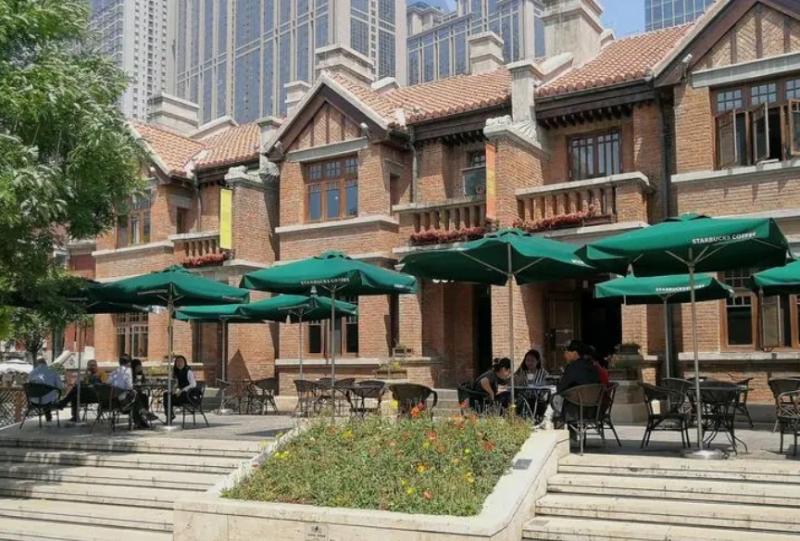Tianjin Fifth Avenue Xiannong Courtyard
Xianong Courtyard is located in the Five Great Avenues area of Heping District, Tianjin, at the intersection of Hebei Road and Luoyang Road. This building, constructed in 1925, was designed by the British engineer Mr. Red for Xianong Engineering Co., Ltd. The courtyard covers 4,188 square meters with a building area of 5,355 square meters. Named after its primary residents, the employees of Xianong Company, the courtyard features an inner lane layout with row houses on the outside. The buildings are arranged in a peripheral style, with units comprising reception rooms and kitchens on the ground floor, and bedrooms, bathrooms, and storage rooms on the second floor. Despite enduring 88 years of history, the building remains well-preserved and has housed notable figures such as the famous banker Tan Lisun and the renowned medical scientist Wu Qingyuan.

Reference: Tianjin Wudadao: A Cultural and Historical Tourism Area
History and Restoration of Xianong Courtyard
After seven years of meticulous planning and development, Xianong Courtyard officially opened to the public on October 13, 2013. This addition follows the Minyuan Xili Cultural and Creative Block and the Jingyuan Hotel Boutique Cultural District as yet another historical block in Tianjin that combines cultural heritage with modern fashion. Located in the area with the highest concentration of historical buildings in Tianjin, Xianong Courtyard lies north of Minyuan Stadium and has a planned construction area of 25,400 square meters. The first phase of the project includes Xianong Courtyard and the Meng Mansion.
Historical Background
Designed by the British engineer Mr. Red, Xianong Courtyard got its name because it housed many employees of Xianong Company. Xianong Company, one of the earliest and largest real estate companies in Tianjin, epitomizes the history of foreign real estate business in Tianjin. Among the seven founders of Xianong Company, the American Herbert Hoover is a well-known figure. After earning his first fortune in Tianjin, Hoover returned to the United States, where his experiences in China significantly aided his election as the 31st President of the United States.
Restoration Project
In 2006, the Tianjin Historical Architecture Restoration Company initiated the restoration of Xianong Courtyard. The restoration process emphasized leading restoration technology and comprehensiveness, adhering to the principles of prioritizing preservation, reasonable utilization, restoring old buildings to their original state, and ensuring safety and applicability. Through detailed historical research and on-site surveys, the historical, cultural, urban landscape, and architectural values of the district and its buildings were clarified. The restoration project not only restored the original red brick sloped roof appearance but also preserved the original architectural style. Modern functionalities such as heating and air conditioning systems were added, along with insulation layers and antique-style double-pane windows to improve energy efficiency and safety.
New technologies, materials, and processes were employed, including a proprietary technology for restoring damp-proof layers without damaging the building's facade. This innovative method, which injects a silicone-based hydrophobic agent into the mortar joints of brick structures, was successfully tested using infrared thermal imaging and spectroscopy. This technology minimizes disturbance to the building's walls and has a much shorter construction period than traditional methods, earning wide acclaim.
Commercial Operations of Xianong Courtyard
The business positioning of Xianong Courtyard adheres to the principle of "culture as the soul," featuring a blend of dining, fashion, art, and leisure establishments. High-end dining brands such as the North China flagship store of Starbucks, the Hong Kong Legend Cantonese restaurant, CHOLITO Spanish restaurant, IGOSSO Italian restaurant, and Tianjin’s first Lijiang-themed restaurant Yizu Yiwang, among others, have all opened here. Additionally, top international home goods integrator Crossover Gathering and renowned cultural enterprise Hehouzhai enhance the cultural atmosphere of the block, showcasing a perfect blend of ancient and modern, and the integration of Eastern and Western cultures.
Public Art Plaza
As a public art plaza on the Five Great Avenues, Xianong Courtyard bridges the gap between artists and the audience, transforming the block into a vibrant public art space. It carries the city's history and cultural heritage, bringing art closer to urban life through various exhibitions, cultural salons, and artistic performances. The public art plaza fosters cultural openness, sharing, and exchange, using art to illuminate urban life.
Phase II Project Outlook
The second phase of the Xianong Courtyard project began in the second half of 2013, with operations expected to start in October 2014. When completed, the area surrounding Minyuan Plaza will become a major cultural tourism hub, significantly enhancing the cultural, commercial, and tourism value of the Five Great Avenues. This area is set to become the city’s top region in terms of cultural value, wealth creation, and economic benefits.
Conclusion
Xianong Courtyard is not just a historical building complex but also an integral part of Tianjin's urban culture. Through scientific restoration and reasonable utilization, Xianong Courtyard has preserved its historical character while embracing modern functionality and vitality. As a shining star on the Five Great Avenues, Xianong Courtyard continues to witness and promote the development and prosperity of Tianjin city.
QA Section
Q1: Who were some notable residents of Xianong Courtyard?
A1: Notable residents of Xianong Courtyard included the famous banker Tan Lisun and the renowned medical scientist Wu Qingyuan.
Q2: What technological advancements were used in the restoration of Xianong Courtyard?
A2: The restoration of Xianong Courtyard employed innovative technologies, such as a proprietary method for restoring damp-proof layers using a silicone-based hydrophobic agent, which minimizes disturbance to the building's walls and significantly shortens the construction period compared to traditional methods.